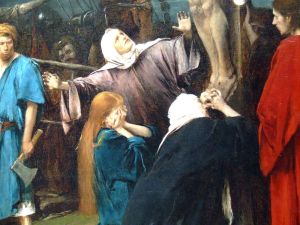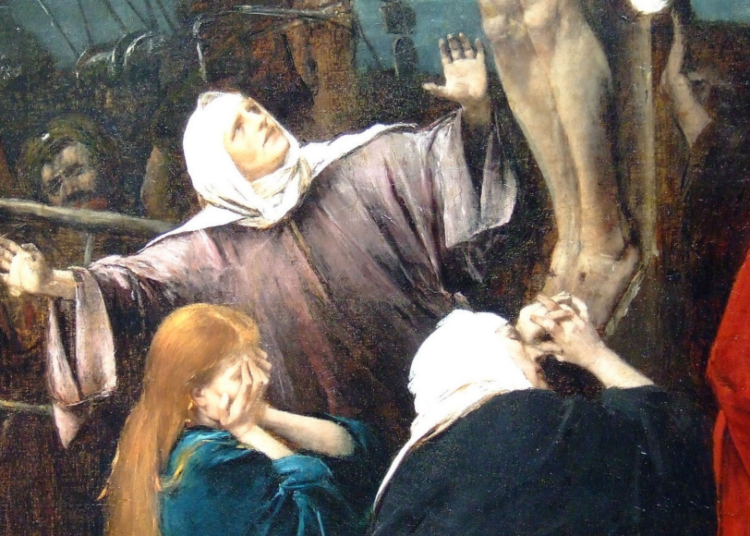“Golgotha” is one of those works, and Frank Martin is one of those composers, about whom you want to broadcast to the world their greatness, beauty, and importance.
 Writers of a conservative inclination are prone to issue blanket condemnations of the fine art produced in the 20th century. But this is a gross oversimplification. Much 20th-century art and music, far from mocking the past or expressing nihilism and relativism, continued the grand Western heritage in new ways, reflecting timeless spiritual and aesthetic values. The traditions of classical music, far from being dried up by 1900, continued to flourish and to rise to more intense heights as composers, inspired by the events of their times, pushed tradition into new creative directions.
Writers of a conservative inclination are prone to issue blanket condemnations of the fine art produced in the 20th century. But this is a gross oversimplification. Much 20th-century art and music, far from mocking the past or expressing nihilism and relativism, continued the grand Western heritage in new ways, reflecting timeless spiritual and aesthetic values. The traditions of classical music, far from being dried up by 1900, continued to flourish and to rise to more intense heights as composers, inspired by the events of their times, pushed tradition into new creative directions.
French-speaking composers were at the forefront of a newspiritual direction in music in the 20th century. Blending Gregorian chant with Impressionist harmonies, Maurice Durufléwrote exquisitely crafted, deeply felt choral works rooted in the Catholic liturgy that have found a secure place in both churches and the concert hall. Others, such as Arthur Honegger, AndréCaplet, Francis Poulenc, Eugène Ysaÿe, and Olivier Messiaen,reflected on modern times through music of passionate urgency, using the expanded resources of tonal harmony—including an increased role for dissonance—to reflect inner or outer struggles and the striving for transcendence.
For me, the Swiss composer Frank Martin (his name is French and should be pronounced something like “fronk mar-TAN”) is one of the greatest of this group. As we mark the 50th anniversary of his death this year, Martin’s work is not nearly as well knownas it should be. Amid the deluge of music written in the 20thcentury, Martin’s work stands out for its integrity, humanism, and striving for beauty within a framework of changing conceptions of harmony, melody, and rhythm. In an age in which composers were lined up along various ideological battle lines of “progress,” Martin stood apart, synthesizing various traditional and modern influences and, in general, simply writing what he felt was beautiful and meaningful. It looks increasingly as if Martin might be one of the greatest composers of modern times.
Frank Martin was born in Geneva, Switzerland in 1890 as the tenth and youngest son of a Huguenot pastor. He would later say of himself: “As the son of a minister, and as the son of a minister who has not renounced his faith, religion has affected me twice as strongly.” At the age of 12 Martin received the first impetus that would lead to his becoming a composer: he heard a performance of Bach’s St. Matthew Passion in Geneva’s cathedral, an experience that marked him for life. Bach would remain Martin’s musical idol.
Being Swiss, Martin had access to both the French and German musical traditions and was able to blend them in his music. His works have both a German gravitas and grandeur and a cool French refinement. Although interested in the modern harmonic theories of Arnold Schoenberg, Martin could not embrace them in their strict form, nor did he wish to abandon tonality. He was far too interested in music as a free, emotional communication. Religion was a continual source of inspiration, choral music a specialty: the Mass for double choir, a Christmas cantata, the oratorio In Terra Pax—all products of his intense Christian faith(one that was broader than Calvinism as such). And then there were several brilliant and well-received instrumental works, like the Petite Symphonie concertante, the Concerto for 7 Winds, Percussion, and Strings, and other concertos and symphonies which placed Martin among the distinguished composers of the time—yet a composer always standing aloof from the crowd and indifferent to passing fads.
In the spring of 1945, spiritual things were again on Martin’s mind. World War II was concluded, the harshest trial Europe had ever been through. Some had survived, many others had perished. Many parts of the continent lay in utter destruction, both physical and moral. Martin happened upon an etching by Rembrandt, created in 1653 and entitled The Three Crosses. He was immediately struck by the lighting effect in this Crucifixion scene: while the onlookers are enshrouded in darkness, the figure of Jesus on the cross is illuminated by an extraordinary white light. As Martin later commented: “on this small surface of paper we see the moment in world history where the fundamental incompatibility that exists between our material world and the world of the spirit was most dazzlingly manifested.”
Martin conceived the idea of expressing this same contrast in musical terms, in a work for singers and instruments in the tradition of the Passion oratorio, a hallowed genre graced most famously by the masterpieces of Bach, the St. John Passion and St. Matthew Passion.
Martin’s characteristic humility and modesty in treating this mighty subject showed itself: he felt unworthy to follow in Bach’s footsteps. Yet as his ideas progressed, he realized that he could express the theme in his own style and language.
One of the ways in which Martin’s oratorio differs from Bach’s is that Martin fashioned a text (in French) from the Passion narratives of all four gospels, selecting several key episodes for a more concentrated focus. Some details, like Peter’s denial, are left out. Everything serves the concept inspired by Rembrandt’s picture: “to concentrate all the light on the person of Christ, leaving all the other protagonists in the shadows.” Jesus, who is portrayed by a baritone, sings in a measured and serene musical recitative, rising to a more forceful declamation in the passages against the hypocrisy of the Pharisees. The crowd is portrayed by the chorus, the High Priest and Pilate by a tenor.
Just as Bach had leavened his Passion narrative with poetic reflections (often sung by solo singers in the form of arias), Martin did similarly, but in his case the text for these moments of relief came from the highest source imaginable: St. Augustine’s Confessions and Meditations. These Augustinian passages are interspersed between the various scenes of the Passion.
The opening movement of Golgotha is searingly powerful, heartbreakingly sorrowful, like the equivalent movements in the Bach Passions. The chorus sings a prayer from Book 10 of Augustine’s Confessions: “Father! Father! Father! How far hast Thou, good Father, loved us all! … Thou hast not spared Thine only son, Thou hast delivered Him up for us.” Throughout the oratorio, the accent is on the meditative and the reflective more than the dramatic—although dramatic tension is not lacking in the scenes with the High Priest and Pontius Pilate. Moments like the Last Supper scene have a profound calm. The “hosannas” of the chorus greeting Jesus’ entry into Jerusalem are overwhelmingly glorious; as Robert R. Reilly has commented, “this music will either send chills down your spine or put tears in your eyes, or both.”
And what of the climax of the work, the Crucifixion itself? In Martin’s vision (“Le Calvaire”) it is as restrained, somber, and subdued as one could imagine the event being portrayed. The scene itself is brief and dignified, like a scena from an opera, and it immediately opens out into a long meditation for the solo tenor with text from Augustine: “When Thou lookest on Thine only Son, so tenderly beloved and delivered up to death on the cross, Almighty Father remember our distress!” The effect is like a believer pausing reverently to meditate at one of the individual Stations of the Cross.
In contrast to Bach, who ended his Passions with Jesus’ entombment, Martin chose to open his oratorio out to the joyand wonder of the Resurrection. The final movement has a text from 1 Corinthians (“O Death, where is Thy sting? O Thou grave, O where is Thy victory”) and from the Holy Saturday liturgy (“It is the night of blessed gladness when Jesus Christ, casting off the chains of Death, comes forth victorious from the tomb.”) The tonality of the music brightens, ending in a luminous major key with the angelic-sounding sopranos of the chorus singing of eternal light in the text from Augustine: “O light both real and certain from whom all light flows in abundance!”
Golgotha was premiered in Geneva in April 1948; Martin had composed it without a commission and or any definite prospects for a performance, simply as an act of faith and devotion. The work portrays the Passion with a modern objective spirit, in Martin’s words aiming “to present the event per se, allowing the listener to draw his own conclusions from it.”
Stylistically, Martin’s music has been described as what happens when J. S. Bach meets Claude Debussy. This is apparent right from the start: anyone familiar with Bach’s St. John Passion will not miss how the chorus’s invocations of “Père” (Father) directly recall the cries of “Herr” (Lord) at the beginning of the Bach work. And though Martin’s music has a Bach-like intensityand weight, pervading everything is a luminous transparency like stained-glass windows. This is due to Martin’s use of harmony. His complex, expressively dissonant chords often have a sweet euphony at their core, as if hinting at the divine plan that underlies the apparent tragedy of the Passion. One is struck by how Martin, within the pain and suffering of his subject, is always in search of beauty, elegance, sophistication: qualities always at the disposal of this understated francophone. Golgotha expresses a deep sorrow yet, at the end, a radiant hopefulness not quite like anything else in music.
One of the ways in which a modern composer could confront the Passion, which Martin shows us so beautifully here, is through the expanded harmonic vocabulary. The tradition of chromaticism (or “black-note harmony”) is apt at conveying instability, darkness, and evil. Contrasted with this is beatific light as symbolized by clear, diatonic major-key chords. Such a musical journey is clearly charted throughout Golgotha. And the newly enriched musical language allows a composer to express certain emotions with greater intensity than before—emotions like bitter irony and sarcasm, conveyed through dissonant harmony and jagged rhythms in the trial scenes of Golgotha.
Golgotha is one of those works, and Frank Martin is one of those composers, about whom you want to broadcast to the world their greatness, beauty, and importance. He provides a model for how to combine tradition with modernity in the most artistically distinguished way. Especially now, we need to open our minds, eyes, and ears to these artistic riches of the early-to-mid 20th century that are in danger of falling into neglect. At the very least, the magnificent Golgotha should be a goad to rediscover other works by this modern master.
The Imaginative Conservative applies the principle of appreciation to the discussion of culture and politics—we approach dialogue with magnanimity rather than with mere civility. Will you help us remain a refreshing oasis in the increasingly contentious arena of modern discourse? Please consider donating now.
The featured image is “Golgota” (1884) by Munkácsy Mihály, and is in the public domain, courtesy of Wikimedia Commons.


